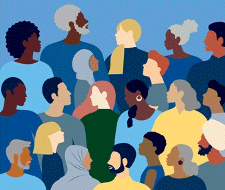Cultural sensitivity is an ongoing process of self-assessment that helps all of us develop skills, attitudes, and behaviors to better understand people from diverse cultural backgrounds. It means you are “culturally humble”—understanding that you are not the expert in all cultural matters.

Source: NIH.
Cultural sensitivity helps us manage prejudices and stereotypes that can affect interactions with people from different cultures and backgrounds and helps us understand that a person’s cultural and personal beliefs affect their perceptions of health, illness, and death, beliefs about causes of disease, and approaches to health promotion. Cultural sensitivity helps us understand that culture influences how illness and pain are experienced and expressed, where patients seek help, and the types of treatment patients prefer (Mayhew, 2018).
1.1 Self-Awareness and Self-Assessment
Self-awareness and self-assessment of cultural concepts are closely related to health equity, showing us that values often assumed to be universal can be relative in nature. These practices help us understand the influences of diverse but interrelated determinants of health and offers new models of care that account for more than just biology and medicine.
Test Your Knowledge
You may find it helpful to try these 10 “True or False” questions first before reading the course. The answers are at the end of the question list.
- Implicit bias is a conscious process based on intentional mental associations.
- Health equity means that everyone has a fair and just opportunity to be as healthy as possible.
- Structural racism refers to ideologies, practices, processes, and institutions that produce and reproduce differential access to power and to life opportunities along racial and ethnic lines.
- Cultural sensitivity is a respect for another person’s strengths, culture, and knowledge.
- A type of unconscious bias that occurs when our perception is skewed based on inaccurate and overly simplistic assumptions about a group or person is called perception bias.
- Evidence shows that interventions focusing on social determinants of health rarely lead to better health outcomes.
- Perception bias is a type of unconscious or implicit bias that occurs when our perception is skewed based on inaccurate and overly simplistic assumptions about a group a person “belongs” to.
- Historically embedded structural racism is a fundamental cause of health inequities in the United States.
- Measures of implicit bias rely on the assumption that automatic associations between two concepts will influence behavior in a measurable way.
- Bias training has been shown to be more effective when the approach is multipronged, designed with context and professional identity in mind, and when people work and train together.
Answers: Questions 1 and 6 are False; all the others are True.
Source: NIH.
1.2 Background
Cultural sensitivity in healthcare is not a new concept—it has been studied in the field of nursing at least since the 1970s. Early research included the analysis of different cultures, nursing care practices, values and beliefs, and concepts of health and disease (Gradellini et al., 2021).
In 2002, the National Academies published a comprehensive assessment of racial and ethnic disparities in healthcare. The report, Unequal Treatment: Confronting Racial and Ethnic Disparities in Health Care analyzed barriers to accessing care, historic and contemporary inequities, and pressures for cost-containment. They looked at the clinical encounter itself and found evidence that stereotyping, biases, and uncertainty on the part of healthcare providers can all contribute to unequal treatment (IOM, 2003).

Course: CDC.
The report found that people in racial and ethnic minority groups received lower-quality healthcare than Whites received, even when they were insured to the same degree and when other healthcare access-related factors, such as the ability to pay for care, were the same. Clients in minority groups were also not getting their needs met in mental health treatment. The IOM report was a primary impetus for the cultural competence movement in healthcare (Stubbe, 2020).
Cultural sensitivity, cultural awareness, cultural safety, cultural humility, and cultural competence are closely related concepts. Awareness means you strive to improve your understanding of the norms and customs of multi-cultural groups. Safety means you work to protect the culture of vulnerable groups by identifying biases and power imbalances within organizational structures. Humility means you keep an open mind and a non-judgmental approach to patient care (Shepherd et al., 2019). Competence means you integrate knowledge into specific standards, policies, practices, and attitudes.
Healthcare providers who are unaware or insensitive to the process by which cultural identity develops can—regardless of their own race or ethnicity—often unwittingly minimize the importance of racial and ethnic experiences. This means they may fail to identify cultural needs or recommend appropriate treatments. They can operate from a superior perspective, take a patient’s reactions or disagreements personally, and view a client through a veil of societal biases or stereotypes (SAMHSA, 2016).
1.3 How Culture Influences Healthcare Providers and Affects Patients
Whether you are aware of it or not, culture influences healthcare practices and can affect a provider’s perceptions, practices, and decision-making. All forms of knowledge and practice are influenced by culture.
Culture can commonly be divided into two broad categories: collectivistic or individualistic. Most cultures include characteristics of both, although within any given culture, there are individual variations. Being familiar with characteristics of collectivistic and individualistic cultures helps practitioners personalize patient care and understand where patients and family members fall within their cultural continuum (Mayhew, 2018).
Characteristics of Collectivistic and Individualistic Cultures | |
|---|---|
Collectivistic | Individualistic |
Focus on “we” | Focus on “I” |
Promote relatedness and interdependence | Value autonomy |
Connection to the family | View ability to make personal individual choices as a right |
Value respect and obedience | Emphasize individual initiative and achievement |
Lesser influence of group views and values, and in fewer aspects of life | Greater, broader influence of group views and values |
Emphasize group goals, cooperation, and harmony | |
1.4 Creating a Respectful Healthcare Environment
The foundation of good quality healthcare rests on respectful, non-judgmental decision making and good clinical reasoning. Respect means recognizing a patient’s value and honoring or acknowledging their dignity. Respect strengthens a clinician’s moral commitment to their patients and supports authentic interactions. Conveying respect has positive effects on health outcomes, patient satisfaction, and mutual trust (Bridges et al., 2021).
Healthcare organizations demonstrate respect by incorporating the perspectives of patients and community members into their policies and practices. Equitable access to care is a priority. Clinicians and organizations should be responsive to feedback from patients about how best to build a patient-centered culture of respect. Learning about a patient’s experiences of respect helps build clinical partnerships and promotes positive health outcomes (Bridges et al., 2021).
Historical factors have influenced healthcare practices and have contributed to a mistrust of the healthcare system. For example, patients from Indigenous and culturally and linguistically diverse backgrounds frequently report that healthcare staff is disrespectful, unwelcoming, and unfriendly. Healthcare personnel can provide a safe cultural environment by reflecting of their own cultural beliefs, understanding patient rights, and acknowledging patient-clinician power dynamics (Kayrouz et al., 2021).
1.5 Morality, Ethics, and Cultural Competence
Morality plays a fundamental role in the functioning of any human society by regulating social interactions and behaviors. Morality involves a set of values, implicit rules, and principles. This includes long-standing, shared cultural customs that guide social behavior (Bentahila, Fontaine, and Pennequin, 2021).
Ethics, morality, and culture are strongly related. In general, Western countries emphasize the ethical concepts of autonomy and the individual, while Eastern countries tend to emphasize autonomy and community. Some Eastern cultures, advocate the ethics of community and of divinity (Bentahila, Fontaine, and Pennequin, 2021).
Cultural differences depend upon the importance of certain ethical principles (Bentahila, Fontaine, and Pennequin, 2021):
- Autonomy—protects the individual, their liberty, and their rights, to help them satisfy their needs, and achieve their goals.
- Community—protects the integrity of the group, its structure, its organization, its reputation, as well as the roles and the status of its members.
- Divinity—insists upon protecting the soul and the spirit, as well as all the spiritual aspects of the individual and their natural environment.
Understanding and awareness of these differences involves basing decisions on a combination of medical knowledge and moral principles, including beneficence, non-maleficence, autonomy, justice, and respect for persons.
Beneficence is the act of being kind. Non-maleficence means do no harm. Autonomy is the respect for individual rights and freedoms. Justice is the degree to which healthcare services are distributed equitably throughout society as well as how healthcare is delivered at the individual level. Respect means recognizing a patient’s value and honoring or acknowledging their dignity.
The principle of justice is perhaps the most relevant to cultural competence and diversity. It states that people have the right to be treated fairly and equitably. It means respecting the rights of individuals and treating all patients the same regardless of who they are (Olejarczyk and Young, 2022).
Ethical challenges, conflicts, or dilemmas can influence the care and treatment of patients. One such ethical threat is placing materialistic self-interest and profit over ethical care. Another is ethical questions related to scientific advances such as mapping of the human genome. Genetic advances have made possible some procedures that raise ethical issues. Should something like the cloning of animals—even humans—be allowed simply because the procedure is possible?
Healthcare quality measurements created by insurers, professional organizations, and government agencies can create ethical dilemmas because they often fail to incorporate the voices of diverse communities, leading to a lack of understanding of the needs of the entire population. Until these diverse voices are heard, communities experiencing social injustices caused by historical, racial, and systemic violence will continue to experience healthcare disparities (Culhane-Pera et al., 2021).
